外研版(2019)选择性必修第三册Unit 3 War and peace Understanding ideas 课件(34张ppt)
文档属性
| 名称 | 外研版(2019)选择性必修第三册Unit 3 War and peace Understanding ideas 课件(34张ppt) |  | |
| 格式 | pptx | ||
| 文件大小 | 39.3MB | ||
| 资源类型 | 教案 | ||
| 版本资源 | 外研版(2019) | ||
| 科目 | 英语 | ||
| 更新时间 | 2022-10-30 10:03:47 | ||
图片预览

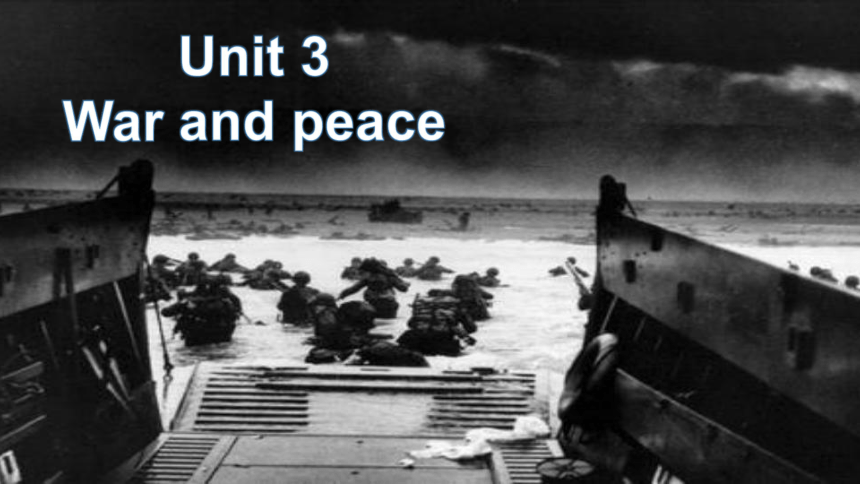

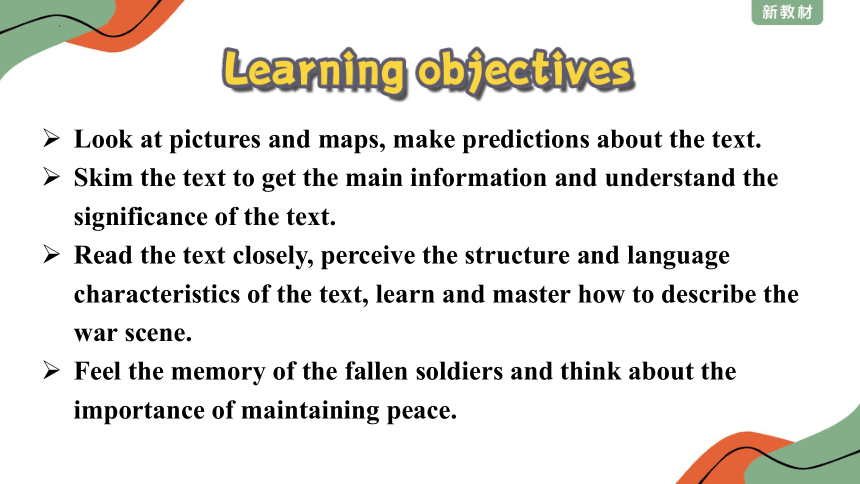
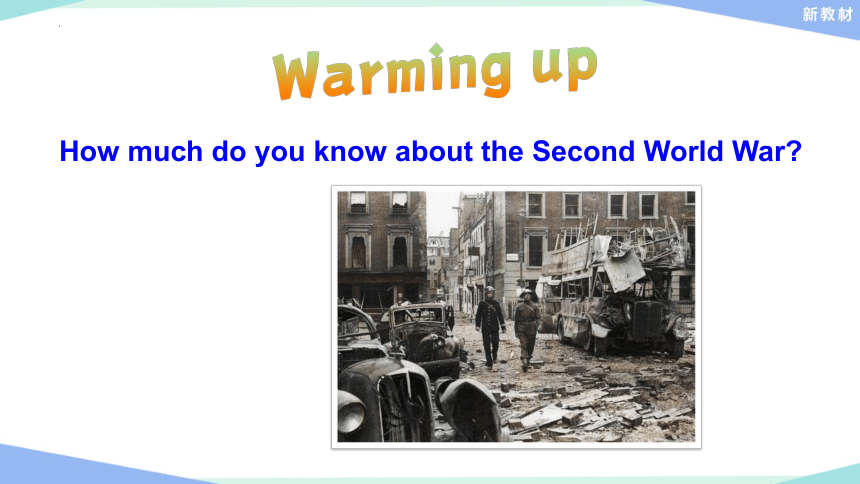
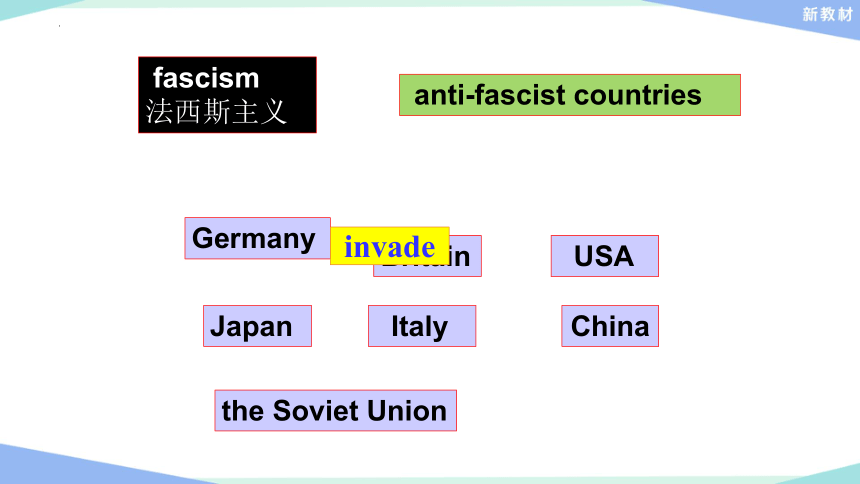

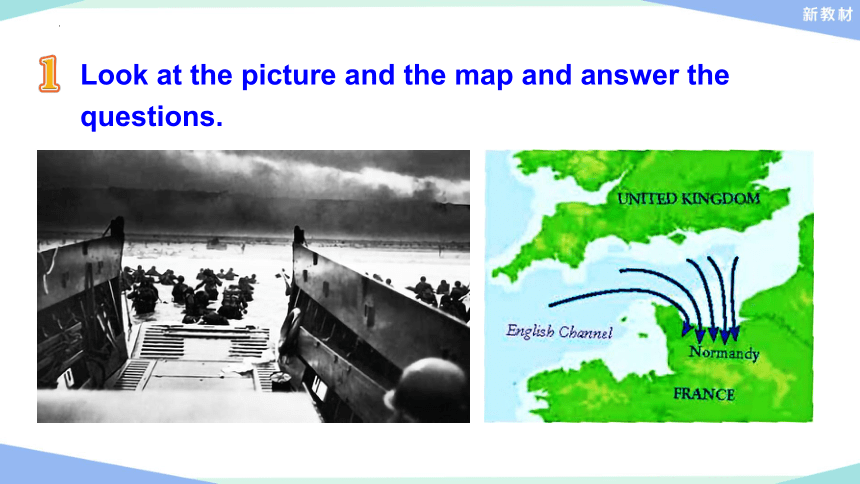
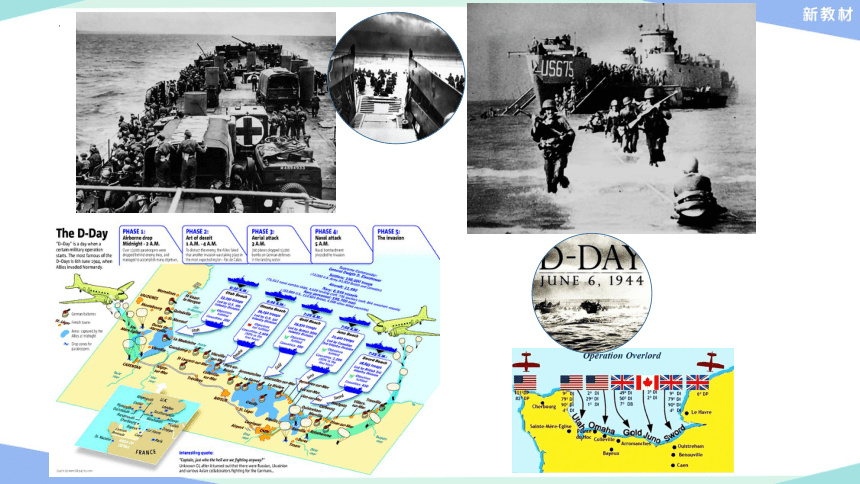
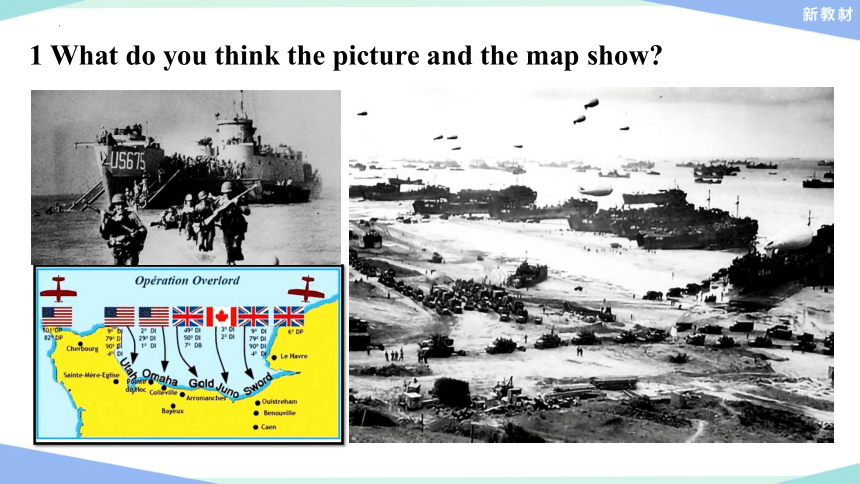
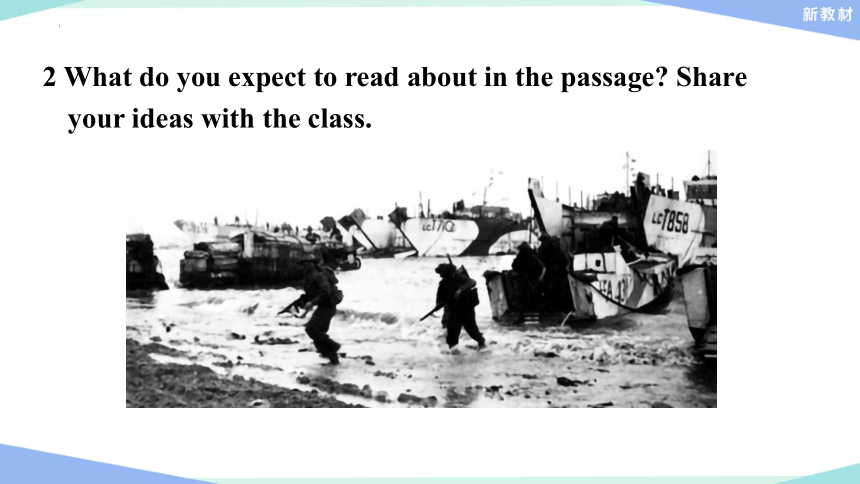
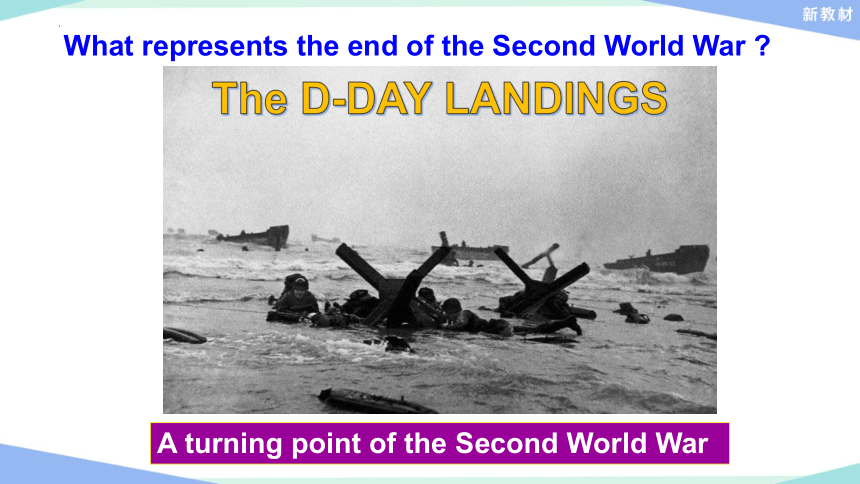
文档简介
(共34张PPT)
Unit 3
Unit 3
War and peace
The D-DAY LANDINGS
Look at pictures and maps, make predictions about the text.
Skim the text to get the main information and understand the significance of the text.
Read the text closely, perceive the structure and language characteristics of the text, learn and master how to describe the war scene.
Feel the memory of the fallen soldiers and think about the importance of maintaining peace.
How much do you know about the Second World War
fascism
法西斯主义
anti-fascist countries
Germany
Japan
Italy
USA
Britain
the Soviet Union
China
invade
Allies:
Countries that fought against the Axis Powers.
Axis Powers:
The alliance of Germany, Italy, and Japan.
Second World War Glossary
轴心国
同盟国
Operation Overlord:
code name for the military operation in 1944 to invade France.
霸王行动
Look at the picture and the map and answer the questions.
1 What do you think the picture and the map show
2 What do you expect to read about in the passage Share your ideas with the class.
What represents the end of the Second World War
The D-DAY LANDINGS
A turning point of the Second World War
The LANDINGS
“D” refers to the day of the operation which actually begins dependent on final approval.
D-day: The term D-Day is used for the day on which an attack or operation is to be launched.
D是Day的首字母,在军事活动中,D日经常用作表示一次作战或行动发起的那天。
迄今为止,最著名的D日是1944年6月6日-诺曼底战役打响之日 - 即同盟国反攻在第二次世界大战中被纳粹德国占领的欧洲大陆的开始。
D-DAY
The
D-Day landings意思是行动日登陆,标题用的是时间而不是诺曼底这个地点。
D-Day landings:
D-Day Invasion or Invasion of Normandy.
D-DAY LANDINGS
The D-DAY LANDINGS
Map of D-Day Landings
Which countries joined in the landings
American, British and Canadian forces
Why did these countries launch the D-Day landings
Germany
Poland
France
invade
The US
Britain
Canada
to attack
to help?
to attack to help?
to attack
to help
invade
Now read the passage and check your prediction.
The Normandy Landings
The Normandy landings were a seaborne invasion of northern France that took place on Tuesday, 6 June 1944 by American, British and Canadian forces. The largest seaborne invasion in history was code-named “Operation Overlord”, but it is more often referred to as “D-Day”. It enabled the liberation of France from German occupation, laying the foundations for the defeat of the German armies on the Western Front.
Match the main ideas to the paragraphs and give your reasons.
The outcome of the operation
The background information of the operation
The severe casualties on Omaha Beach
The everlasting memory of the soldiers’ brave actions
The initial stage of the operation
The order issued by the Supreme Allied Commander before the operation
The 70th anniversary of the D-Day landings
Organise information from the passage and complete the fact file.
The D-Day landings
Date: ______________
Place: ___________________________
Aim of the operation: _____________________________________________________
________________________________________
Supreme Allied Commander: _______________________
6 June 1944
the Normandy beaches
to reach the Normandy beaches along about 80 kilometres of French coastline
General Eisenhower
Timeline of the operation:
Spring 1944 Allied troops _________________________
6 June 1944
Start of _________________________
dawn: thousands of troops were journeying across ________________________________
mid-morning: hundreds of soldiers ___________________________________________________
the Normandy landings
the English Channel to Normandy
lay dead in the water and amongst the tanks on the beach
gathered in large numbers.
August 1944
The Allies liberated Paris and the Germans
__________________________________________
Outcome of the operation:
____________________________________________________________________________________________________________
______________________________________________________
despite the high cost in human life, the D-Day landings were a success and were seen widely as the beginning of the end of Second World War
were removed from northwest France.
Now think about how the author of the passage presents historical facts to a powerful effect.
Date: ___________________________________
Place: ___________________________________
Aim : ___________________________________
Characters: _____________________________
Timeline of the operation:__________________
Outcome of the operation: _________________
The D-Day landings were the largest combined sea, air and land operation in history. The operation was seen widely as the beginning of the end of the Second World War.
1 What is the historical significance of the D-Day landings
2 What is your understanding of the poem For the Fallen
For the Fallen
Laurence Binyon’s ‘For the Fallen’ (1914) is one of the most widely quoted poems of the First World War. Unlike Wilfred Owen’s ‘Futility’, it wasn’t written from the trenches but by a poet back home, reflecting on the sacrifice thousands of men on the Western Front were making every week.
The poem’s central message is clear enough, calling attention to the noble sacrifice made by men who laid down their lives for England.
The dominant tone of the poem is proudly patriotic, solemn yet celebratory of the bravery of the soldiers.
3 How can you use the language you have learnt to describe another event during the Second World War Share your ideas with the class.
Date: ___________________________________
Place: __________________________________
Aim : ___________________________________
Characters: _____________________________
Timeline of the operation:__________________
Outcome of the operation: _________________
If you were a survivor from the D-Day Landings, what do you want to say to the people today
We must cherish the peace acquired at the cost of blood and life!
There will be no war in the world forever.
Hope our world will be full of love, peace and happiness.
Read the poem “For the Fallen”.
Unit 3
Unit 3
War and peace
The D-DAY LANDINGS
Look at pictures and maps, make predictions about the text.
Skim the text to get the main information and understand the significance of the text.
Read the text closely, perceive the structure and language characteristics of the text, learn and master how to describe the war scene.
Feel the memory of the fallen soldiers and think about the importance of maintaining peace.
How much do you know about the Second World War
fascism
法西斯主义
anti-fascist countries
Germany
Japan
Italy
USA
Britain
the Soviet Union
China
invade
Allies:
Countries that fought against the Axis Powers.
Axis Powers:
The alliance of Germany, Italy, and Japan.
Second World War Glossary
轴心国
同盟国
Operation Overlord:
code name for the military operation in 1944 to invade France.
霸王行动
Look at the picture and the map and answer the questions.
1 What do you think the picture and the map show
2 What do you expect to read about in the passage Share your ideas with the class.
What represents the end of the Second World War
The D-DAY LANDINGS
A turning point of the Second World War
The LANDINGS
“D” refers to the day of the operation which actually begins dependent on final approval.
D-day: The term D-Day is used for the day on which an attack or operation is to be launched.
D是Day的首字母,在军事活动中,D日经常用作表示一次作战或行动发起的那天。
迄今为止,最著名的D日是1944年6月6日-诺曼底战役打响之日 - 即同盟国反攻在第二次世界大战中被纳粹德国占领的欧洲大陆的开始。
D-DAY
The
D-Day landings意思是行动日登陆,标题用的是时间而不是诺曼底这个地点。
D-Day landings:
D-Day Invasion or Invasion of Normandy.
D-DAY LANDINGS
The D-DAY LANDINGS
Map of D-Day Landings
Which countries joined in the landings
American, British and Canadian forces
Why did these countries launch the D-Day landings
Germany
Poland
France
invade
The US
Britain
Canada
to attack
to help?
to attack to help?
to attack
to help
invade
Now read the passage and check your prediction.
The Normandy Landings
The Normandy landings were a seaborne invasion of northern France that took place on Tuesday, 6 June 1944 by American, British and Canadian forces. The largest seaborne invasion in history was code-named “Operation Overlord”, but it is more often referred to as “D-Day”. It enabled the liberation of France from German occupation, laying the foundations for the defeat of the German armies on the Western Front.
Match the main ideas to the paragraphs and give your reasons.
The outcome of the operation
The background information of the operation
The severe casualties on Omaha Beach
The everlasting memory of the soldiers’ brave actions
The initial stage of the operation
The order issued by the Supreme Allied Commander before the operation
The 70th anniversary of the D-Day landings
Organise information from the passage and complete the fact file.
The D-Day landings
Date: ______________
Place: ___________________________
Aim of the operation: _____________________________________________________
________________________________________
Supreme Allied Commander: _______________________
6 June 1944
the Normandy beaches
to reach the Normandy beaches along about 80 kilometres of French coastline
General Eisenhower
Timeline of the operation:
Spring 1944 Allied troops _________________________
6 June 1944
Start of _________________________
dawn: thousands of troops were journeying across ________________________________
mid-morning: hundreds of soldiers ___________________________________________________
the Normandy landings
the English Channel to Normandy
lay dead in the water and amongst the tanks on the beach
gathered in large numbers.
August 1944
The Allies liberated Paris and the Germans
__________________________________________
Outcome of the operation:
____________________________________________________________________________________________________________
______________________________________________________
despite the high cost in human life, the D-Day landings were a success and were seen widely as the beginning of the end of Second World War
were removed from northwest France.
Now think about how the author of the passage presents historical facts to a powerful effect.
Date: ___________________________________
Place: ___________________________________
Aim : ___________________________________
Characters: _____________________________
Timeline of the operation:__________________
Outcome of the operation: _________________
The D-Day landings were the largest combined sea, air and land operation in history. The operation was seen widely as the beginning of the end of the Second World War.
1 What is the historical significance of the D-Day landings
2 What is your understanding of the poem For the Fallen
For the Fallen
Laurence Binyon’s ‘For the Fallen’ (1914) is one of the most widely quoted poems of the First World War. Unlike Wilfred Owen’s ‘Futility’, it wasn’t written from the trenches but by a poet back home, reflecting on the sacrifice thousands of men on the Western Front were making every week.
The poem’s central message is clear enough, calling attention to the noble sacrifice made by men who laid down their lives for England.
The dominant tone of the poem is proudly patriotic, solemn yet celebratory of the bravery of the soldiers.
3 How can you use the language you have learnt to describe another event during the Second World War Share your ideas with the class.
Date: ___________________________________
Place: __________________________________
Aim : ___________________________________
Characters: _____________________________
Timeline of the operation:__________________
Outcome of the operation: _________________
If you were a survivor from the D-Day Landings, what do you want to say to the people today
We must cherish the peace acquired at the cost of blood and life!
There will be no war in the world forever.
Hope our world will be full of love, peace and happiness.
Read the poem “For the Fallen”.
